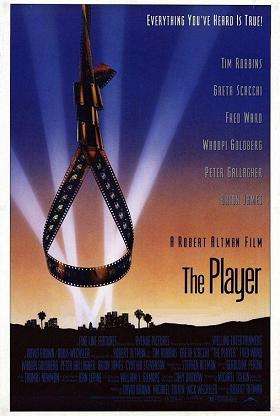The Player

A 1988 satirical novel by Michael Tolkin, The Player was brought to the screen in 1992 by Robert Altman with a screenplay also by Tolkin. The film version starred Tim Robbins, Peter Gallagher and a ton of stars as themselves.
Griffin Mill is a sleazy studio executive whose job it is to decide which screenplays get produced. He finds his life threatened by a stalker, supposedly a screenwriter whose pitch he once rejected. The stalker’s threats drive him over the edge, and he ends up killing the wrong man. Naturally, this is where things go to hell for him.
Tropes used in The Player include:
- Anti-Hero
- The Cameo: Tons and tons of them, most of whom worked for nothing; if they were charged their normal asking prices, the film's budget would've ballooned to $100 million+.
- Conversational Troping: Two guys in the long tracking shot that opens the film talk about other long tracking shots in films.
- Corrupt Corporate Executive: Griffin. You know, our hero.
- Double Meaning Title: In-Universe, in another context, the literal translation of the proposed "Law Procedural" Habeas Corpus ("produce the corpse") also signifies the fact that the screenwriters are pitching a completely ludicrous idea for a movie that has no chance of being successful. Griffin points out the absurdity of it all when he notes that Tom Oakley's pitch distinctly lacks a Second Act; in the originally proposed story, there wouldn't be any meaningful development of the plot or its main character (the District Attorney) until after a sudden plot twist near the very conclusion. Later studio changes after the film gets produced only only take an already absurd premise (for a movie) and make it even stranger.
- Film Within A Film: We see many being proposed. The most prominent one is called Habeus Corpus.
- Focus Group Ending: Mocked; Griffin uses this justification for changing the Downer Ending of Habeus Corpus.
- High Concept: Set in the film industry, this is now a textbook for how to make film pitches.
- Horrible Hollywood: In spades.
- Karma Houdini: Griffin gets away with murder, backstabbing and cheapening an artsy film for the sake of profit. The writer who provoked Griffin into committing the murder pulled off his plan without any hitches, and even became Griffin's accomplice by the end.
- The Nineties: The clothes and hair significantly date the film. Also, many of the cameos are by celebrities whose stars have dimmed since 1992, and are less easy to recognize for present-day viewers watching the movie for the first time.
- The Oner: The opening shot, with improvised dialogue.
- Oscar Bait: In-universe with Habeas Corpus.
- Police Lineup: Griffin appears in one, and a witness's mistake lets him get off the hook.
- Post Modernism: As with many of Altman's films, The Player operates on multiple panes of reality; see They Plotted a Perfectly Good Waste.
- Red Herring: The writer whom Griffith murdered, as well as Griffith's stalker, who was really a detective attempting to turn Griffith in. The real blackmailer was never revealed.
- Rouge Angles of Satin: The first death threat we see reads "YOUR DEAD!"
- They Plotted a Perfectly Good Waste: Many of the film's motifs mirror that of the in-film movie the executives are tampering with. Not only do both have a "Hollywood ending", but they also have big-name actors and arbitrary sex.
- Writers Suck: At best, they're too busy making pitches to actually write screenplays. At worst, they're outright murderers.
This article is issued from Allthetropes. The text is licensed under Creative Commons - Attribution - Sharealike. Additional terms may apply for the media files.